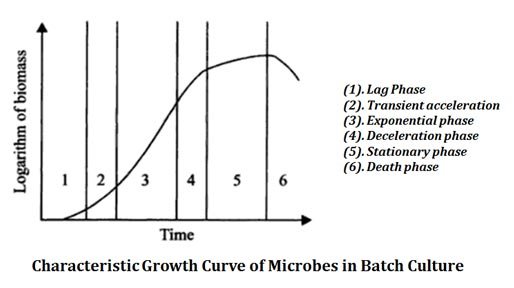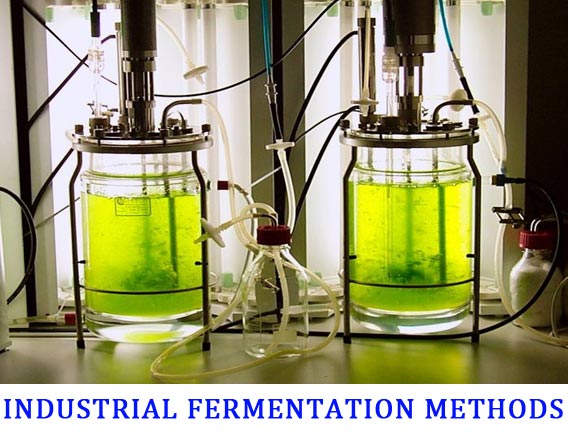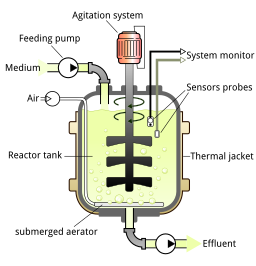Fermentation Technology
Fermentation: An art from the past, a skill for the future…
Brain McNeil
What is fermentation?
Ø Fermentation is a metabolic process which converts carbohydrates to alcohols, organic acids or gases by the activity of enzymes of microbial origin.
Ø Microbes involved in fermentation process: Bacteria and Fungi.
Ø The process of anaerobic respiration in the muscle cells of animals during exercise which produce lactic acid is also a type of fermentation.
Ø The technique of fermentation was very ancient in origin.
Ø Egyptians and Sumerians had the knowledge of the technique of converting starchy grains to alcoholics.
| You may also like NOTES in... | ||
|---|---|---|
| BOTANY | BIOCHEMISTRY | MOL. BIOLOGY |
| ZOOLOGY | MICROBIOLOGY | BIOSTATISTICS |
| ECOLOGY | IMMUNOLOGY | BIOTECHNOLOGY |
| GENETICS | EMBRYOLOGY | PHYSIOLOGY |
| EVOLUTION | BIOPHYSICS | BIOINFORMATICS |
Ø For a microbiologist, the word ‘fermentation’ means many processes such as:
$ A method of mass cultivation of microbes under aerobic or anaerobic conditions.
$ Any biological process occurs in the absence of oxygen.
$ Spoilage of food by microbial activity.
$ Production of alcoholic beverages, organic acids, antibiotics or biopolymers
$ Partial oxidation of carbohydrates
What is industrial fermentation?
Ø The intentional use of fermentation technology for the large scale production of microbial biomass or metabolites is called industrial fermentation.
Ø Fermented products have immense use in food, medicine and other industries.
Ø Modern industrial fermentation units use genetically engineered microbes for the rapid production of desired metabolites.
What is a fermenter?
Ø The heart of industrial fermentation is a ‘Fermenter’.
Ø Fermenter is type of bioreactor*
Ø Fermenter: a system provided with controlled environmental conditions for the growth of microbes in liquid culture and production of specific metabolites.
Ø It is a device in which the microbes are cultivated and motivated to form the desired products.
Ø It is containment system to provide the accurate environment for the optimum growth and metabolic activity of the microbes.
Ø Fermenter prevents the entry and growth of contaminating microbes from outside.
Ø Fermenter: containment system for the cultivation of prokaryotic cells (bacteria) and fungi
Ø Bioreactor: containment system for the cultivation of mammalian or insect cells
Ø A fermenter possesses the following mechanical parts:
$. A large vessel made of stainless or rust free material.
$. Motors provided with an automatic control system.
$. Heaters with thermostat system for providing and manipulating temperature.
$. Pups for the addition or removal of substances and water to the fermenter.
$. Gas source and pipeline system for aeration.
$. Sensors for pH and aeration.
$. Peripheral manual or automatic controlling facilities.
Ø The mechanical components of the fermenter proves:
$. A space for taking raw material (culture media / carbon source)
$. Provide a contamination free environment for the growth of microbes.
$. Maintain optimum temperature in the system.
$. Provide adequate mixing and agitation in the medium.
$. Provide ample aeration for aerobic fermentation.
$. Control and maintain optimum pH condition in the fermenter
$. Monitor the concentration of dissolved oxygen in the system
$. Allow the addition of nutrients in between the fermentation process (in continuous fermentation)
$. Facility for maintaining a wide range of organisms.
$. Provision for collecting over-flow from the fermenter (in continuous fermentation)
What are the different types of fermentation process / methods?
Ø There are three types of industrial fermentation processes based on the methods of fermentation and types of fermenters.
(1). Batch fermentation
(2). Continuous fermentation
(3). Fed-batch fermentation
(1). Batch Fermentation
Ø Microorganism is inoculated into a fixed volume of medium.
Ø As the growth takes place, the nutrients are consumed and the product of growth accumulates in the fermenter.
Ø Product of growth may be of two types: (a) Biomass and (b). Metabolites.
Ø The nutrient environment in the fermenter is continuously changed.
Ø This change in the environment in the fermenter will enforce change in the metabolism of cells.
Ø This also results in the cessation of cell multiplication.
Ø Cessation of growth is due to the scarcity of nutrients and accumulation of metabolites.
Ø Once the microbes reached the stationary phase they start to accumulate the metabolites.
Ø Metabolites are extracted from the fermenter by downstream processes.
Ø After the fermentation is over, the residues are taken out from the fermentation tank, and the vessel is then cleaned and sterilized before next batch of fermentation.
Ø Thus in batch fermentation, the large scale production is done as separates ‘batches’.
Ø Microbes in the batch culture show the following pattern of growth with distinct phases.
 (1). Log phase: initial phase, no apparent growth of microbes, they adapt to the environmental conditions.
(1). Log phase: initial phase, no apparent growth of microbes, they adapt to the environmental conditions.
(2). Transient acceleration: the inoculum begins to grow slowly.
(3). Exponential phase: microbial growth proceeds at the maximum possible rate.
(4). Deceleration phase: decline in the growth rate of microbes
(5). Stationary phase: no overall growth rate (death of the cells equals to the division of cells). Most of the secondary metabolites are produced in this phase.
(6). Death phase: no growth at all, cells starts to die and the population size decreases. Usually the fermentation stops before the death phase.
(2). Continuous Fermentation
Ø Here the exponential growth rate of the microbes is maintained in the fermenter for prolonged periods of time in by the addition of fresh media are regular intervals.
Ø Microbes reach the exponential growth rate and continue as such due to the availability of nutrients.
Ø The exponential growth rate of microbes continues till the vessel becomes completely filled in the cells.
Ø Continuous fermenter possesses devices for the collection of overflow from the vessel.
Ø The metabolite or the product of fermentation is extracted for the overflow by downstream processing.
Ø Thus unlike batch fermentation, in continuous fermentation, the fermentation process never stops in between and it continues to run for a long period of time with the addition of nutrients and harvesting the metabolites at regular intervals.
Learn more: Difference between Batch Fermentation and Continuous Fermentation
3. Fed-batch fermentation
Ø It is a modified version of batch fermentation.
Ø Here the substrate is added in increments at different times throughout the course of fermentation.
Ø Periodical addition of substrate keeps the prolonged log and stationary phase of the microbes in the fermenter.
Ø This results in the rapid increase of biomass.
Ø Consequently increased production of metabolites can be achieved in the stationary phase.
Ø Thus fed-batch technique is an improved version of fermentation by avoiding the disadvantages of batch and continuous fermentation techniques.
<< Back to Biotechnology Notes
| You may also like... | ||
|---|---|---|
| NOTES | QUESTION BANK | COMPETITIVE EXAMS. |
| PPTs | UNIVERSITY EXAMS | DIFFERENCE BETWEEN.. |
| MCQs | PLUS ONE BIOLOGY | NEWS & JOBS |
| MOCK TESTS | PLUS TWO BIOLOGY | PRACTICAL |



Super easily observed
Thank you for that